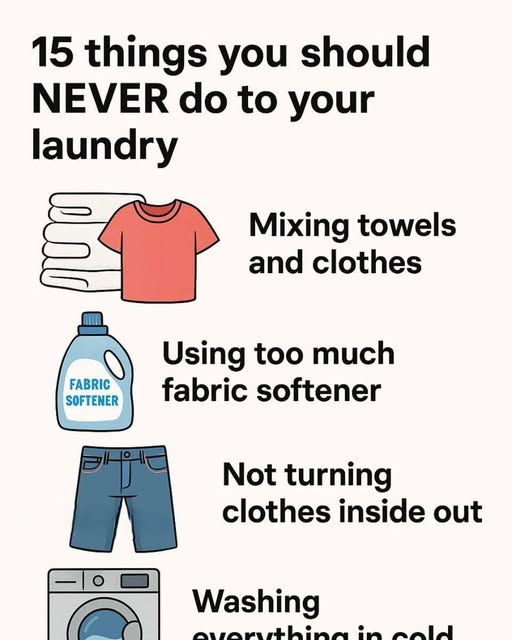Proper laundry care is essential not only for maintaining the appearance and longevity of your clothing but also for ensuring the efficiency and durability of your washing appliances. Many individuals inadvertently make mistakes during the laundering process that can lead to damaged garments, ineffective cleaning, and even appliance malfunctions. In this comprehensive guide, we’ll explore 15 common laundry mistakes and provide expert advice on how to avoid them, ensuring your laundry routine is both effective and efficient.
1. Overloading the Washing Machine
Stuffing too many clothes into the washing machine might seem like a time-saver, but it hinders the machine’s ability to clean effectively. Clothes need space to move around for detergent and water to penetrate fibers properly. Overloading can also strain the machine’s motor and drum, potentially leading to mechanical issues. To ensure optimal cleaning and prolong your machine’s lifespan, follow the manufacturer’s guidelines regarding load capacity.
2. Using Excessive Detergent
More detergent doesn’t equate to cleaner clothes. In fact, using too much can result in residue buildup on garments, making them stiff and attracting more dirt. Additionally, excess suds can lead to mold and mildew growth in the washing machine. Always measure detergent according to the load size and soil level, adhering to the recommendations on the detergent packaging.
3. Ignoring Care Labels
Care labels provide crucial information about how to wash, dry, and iron garments. Disregarding these instructions can lead to shrinkage, color fading, or fabric damage. Before laundering, take a moment to read and follow the care labels to maintain the integrity of your clothing.

4. Washing Whites and Colors Together
Mixing white and colored garments can result in color bleeding, leaving whites looking dingy. To prevent this, separate laundry into whites, darks, and bright colors. This practice helps maintain the original color of your garments and prevents unwanted dye transfer.
5. Not Treating Stains Promptly
Allowing stains to set makes them more challenging to remove. It’s essential to treat stains as soon as possible by blotting (not rubbing) the affected area and applying an appropriate stain remover before washing. Prompt attention increases the likelihood of complete stain removal.
6. Using Fabric Softener on All Fabrics
While fabric softeners can make clothes feel softer, they aren’t suitable for all materials. For instance, using fabric softener on towels can reduce their absorbency. Additionally, some synthetic fabrics may become less breathable. Consider using alternatives like wool dryer balls or white vinegar during the rinse cycle for certain fabrics.
7. Leaving Zippers Unzipped and Buttons Fastened
Unzipped zippers can snag other garments, causing damage during the wash cycle. Conversely, leaving buttons fastened can stress button threads and buttonholes, potentially leading to tears. Ensure zippers are zipped up and buttons are unfastened before laundering.
8. Overusing the Delicate Cycle
While the delicate cycle is gentle on fabrics, it’s not suitable for heavily soiled items or sturdy fabrics like denim. Using it exclusively can result in inadequately cleaned clothes. Reserve the delicate cycle for items labeled as delicate and use regular cycles for more durable garments.
9. Neglecting to Clean the Washing Machine
Over time, washing machines can accumulate detergent residue, lint, and mold, leading to unpleasant odors and reduced efficiency. Regularly cleaning your machine by running an empty hot water cycle with vinegar or a washing machine cleaner helps maintain its performance and hygiene.
10. Drying Everything on High Heat
High heat can shrink, weaken fibers, and fade colors. Delicate fabrics, activewear, and items with elastic should be dried on low heat or air-dried. Always check care labels and adjust dryer settings accordingly to preserve the quality of your garments.
11. Not Emptying Pockets Before Washing
Items left in pockets, such as tissues, coins, or pens, can damage both clothing and the washing machine. Always check and empty all pockets before placing garments in the wash to prevent potential mishaps.
12. Washing Bed Linens Infrequently
Bed linens accumulate sweat, skin cells, and oils, creating an environment for bacteria and dust mites. It’s recommended to wash sheets and pillowcases weekly to maintain hygiene and extend their lifespan.
13. Washing Bath Mats in Home Machines
Heavy, water-absorbent bath mats can become excessively heavy when wet, potentially damaging home washing machines, especially front-loaders. Consider hand washing or using commercial-grade machines at laundromats for such items.
14. Using Fabric Conditioner Excessively
Overuse of fabric conditioner can lead to a buildup that makes clothes feel greasy and less absorbent. It’s advisable to use the recommended amount to avoid residue and maintain fabric integrity.

15. Not Sorting Laundry by Fabric Type
Different fabrics have varying care requirements. Mixing heavy fabrics like towels with delicate items can lead to damage. Sort laundry not only by color but also by fabric type to ensure appropriate washing
Conclusion
Laundry may seem like a simple household chore, but even small missteps can lead to costly damage, reduced clothing lifespan, and inefficient appliance performance. By avoiding these 15 common mistakes—such as overloading your machine, ignoring care labels, or using the wrong wash cycle—you can significantly improve the results of your laundry routine.

















